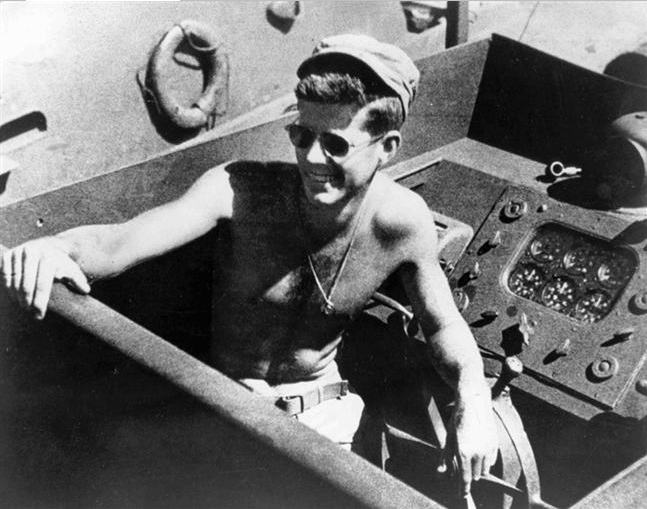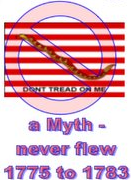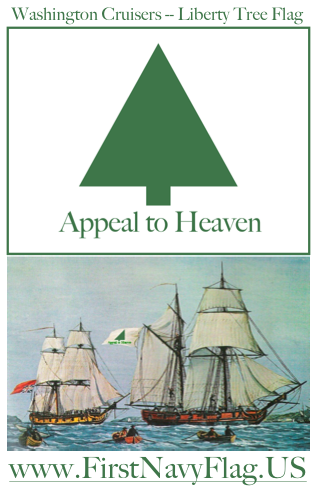Dear Peter Ansoff,
Thank you for your thorough email. It is so refreshing to get thorough, thought-full answers rather than the aggressively abbreviated communications of so much e-mail. Some email notation is reminiscent of the old KLB-47 "Polish typewriter" word groups that are sometimes intelligible but often have far different meanings.
First, today at the Ocean View branch of the Norfolk library, I ordered volume 11 of Raven: Journal... through the I.L.L. I also ordered the book Washington's Navy recommended by the Naval Historical Center. Searching through Auxilliary References I also found a Naval Institute book published in 1995 that I ordered via I.L.L. But I forget to order the one my "Cousin" Thomas Nelson recommended to me related to the question.
A few points in response to your research and writings. In regard to the Stripes and Snake flag currently in use, it is the only rendering of a rattlesnake of four flags (Rhode Island, Pennsylvania, Virginia, and South Carolina) and one coin (from Georgia) where the snake is on its belly in retreat rather than in some posture of being coiled, ready to strike and defend. Given that "posture" of the Stripes and Snake rattler the motto is less a defiant warning than a plaintive plea "Don't tread on me".
I know a bit about snakes in that I was a Boy Scout who earned Reptile Study Merit Badge, had at one time 34 snakes, and even created a "snake coliseum" to have a king snake eat a rattlesnake. I was called "Snake Charmer" by the girls in high school, (I believe there is a country song along those lines which might explain why I did not get many dates in high school...)
In Navy Pilot survival training I stuffed my flight suit with pine straw and waded into the Blackwater River to grab frogs and snakes for our evening supper, and later in EOD Bomb Disposal Training I caught and removed a snake that decided our blast bunker was a nice home. When I was off the coast of Viet Nam in Operation End Sweep, I saw so many sea snakes that I was amazed. The helicopter pilot on our ship said they extended about a mile ahead of the ship and a half mile around. That is more than my 34.
In regard to your other article on the Pine Tree Flag, I believe that is an unfortunate nomenclature, for from my research it has a dual derived meaning. First there as the Cross of Saint George in a White Canton with an evergreen tree, possibly a pine, indeed shaped much that way, that was on the "First New England Flag" as far back as 1686 to 1707.
But while I have not seen a museum piece of the Washington Cruisers flag, it appears to be less symmetrical than the tree in the New England Flag, based on two decidedly second or third hand information images, and again, the Cross of Saint George was removed.
Further in my research, the British Army when they came ashore in early 1775 (?) and occupied Boston they cut down the Tree of Liberty where the Sons of Liberty used to meet. The Brits burned it for firewood, so the account goes. Some evergreen trees burn brightly due to sap, but do not burn for long. But the fire kindled a desire for defiance.
Anyway the sole Tree of Liberty, whether a pine from the former New England flag but without the red Cross of Saint George, or whether a somewhat modified green tree to represent the elm tree that was the Tree of Liberty, became the center image of the canton of the flag flown at Bunker Hill and shown clearly in a painting of a contemporary to the times painter, and is described as either the "Bunker Hill Flag" or the Continental Flag
Given that the Navy Jack was, and is, often the canton of the national flag, it is completely consistent with naval traditions that the Navy jack flag was the white field with the Evergreen Tree of Liberty, that formed the canton of the Continental Flag, and thus the traditionally derived Jack flag for the Continental Navy.
And given that George Washington was mentored by Thomas, Lord Fairfax, a courtier to the Court of Saint James, and was a contributor to the finest literary magazine of the day, Joseph Addison's Spectator, it is likely that George Washington was schooled in the political philosophy of John Locke where in his Second Treatise on Civil Government, Chapter XIV, "Of Prerogative", where is written, quoted as close as I can remember "when we are left with no appeal on earth, then we have the Liberty to appeal to heaven".
So the phrase "Appeal To Heaven" on the flag showing the Tree of Liberty is a further act or expression of defiance, in that it is Locke's syllogism for a "Call To War", a fact that is likely lost on most modern Americans who look at the flag and its defiant, Call To War motto.
Indeed, three days after the Hannah was commissioned on 2 September, she captured the British ship Unity, a most oddly fitting or ironic name of the first ship captured by the Continental Navy.
Note it is not "An Appeal To Heaven" as most modern flag makers wrongly produce, and the error is confirmed by at least two first person sources, Continental Colonel Joseph Reed, aide to General Washington, and Royal Navy Captain, Sir Hugh Pellasier (?sp) who captured the Continental ship named Washington that flew the Evergreen Tree of Liberty flag.
The "floating batteries" description seems to be entirely ill-suited to describe the Hannah, or the six ships who were commissioned by Washington following her. All were ocean going ships, who pursued, engaged the enemy and captured several. That sort of sea going activity is a pretty fair description of a Navy ship commissioned by the Commander in Chief elected unanimously by the Continental Congress just a few months before.
Being that six of seven were named for leaders of the Continental cause, including Franklin (from Pennsylvania, though originally from Massachusetts) and (Harrison, Mercer, Washington and Lee from Virginia), it is hard to describe them as Massachusetts Navy ships even though one was named for Hancock.
Beyond the pines of New England flags and fields, moors and mountains, and the old Navy saying of "in the days of wooden ships and iron men", the tree also connects with the Naval Stores from the loblolly pine trees of Georgia and the Naval Live Oak Forest near Pensacola, as well as a Tree of Liberty in Annapolis that just died a few years ago, and other Tree of Liberty trees in other old towns in America.
And I like to remind folks of the musical Carousel with the show tune words, "My boy bill will be strong and as tough as a tree. Like a tree he will grow, with his head held high, and his feet planted firm on the ground. And no one will every dare to try, to toss him or boss him around..."
Finally, other than being a flag waving patriot since before I was a Boy Scout, and paying dues, what else must I do to become a member of NAVA? (Since I have long been a member of the NAVy.)
James Renwick Manship, Sr.
P.S. Through the good offices of NAVA, might we together try to get the many manufacturers of the Tree of Liberty/Washington Cruisers Flag to correct the "An Appeal..." error, and rename it from the "Pine Tree Flag" to either the Tree of Liberty Flag or the Washington Cruisers flag? Also design wise, I believe from the illustrations the motto should be under the Tree of Liberty.
> -------- Original Message --------
> Subject: FW: Your Raven article and award...
> From: "Peter Ansoff"
> Date: Mon, October 24, 2005 2:02 pm
> To:
> Cc:
>
> Dear James,
>
> Many thanks for your email. My article on the "First Navy Jack" appeared in
> Raven Issue 11, which was published in Fall 2004. The gist of the article
> is that the FNJ probably did not actually exist during the Revolutionary
> War. This conclusion is not really new; I believe that most modern flag
> historians more-or-less agree with it. However, the article takes an
> in-depth look at how the legend of the FNJ originated, and how it came to be
> part of American flag lore. Raven 11 is still in print and is available
> from NAVA; I believe that the per-copy price is $15.00.
>
> You might be interested in two other papers that I have presented over the
> last year or so, and am currently preparing for publication:
>
> 1. "The Sign Their Banners Bore" is a study of the "Appeal to Heaven"/Pine
> Tree flag. As I'm sure you know, this flag is traditionally associated with
> three different activities: a) the "floating batteries" built by
> Washington's army in the Fall of 1775, b) the commerce raiding cruisers that
> Washington commissioned in 1775-76 and c) the Massachusetts State Navy. The
> major conclusions are: a) the floating battery flag did not display a pine
> tree (it was probably an elm), b) the Pine Tree flag was never officially
> adopted for use by Washington's cruisers, and most of them probably never
> used it, although two or three of his captains did so on their own
> initiatives, c) the Pine Tree flag *was* officially adopted by the
> Massachusetts Navy, but does not seem to have been widely used (most of
> their outfitting records and battle reports refer to the Continental or
> American flag). The paper also takes a look at the historical origins of
> the tree symbol and the "Appeal to Heaven" motto. I presented this paper at
> the NAVA meeting in Indianapolis in 2003, and I'm hoping that it will be
> published in the "Flag Bulletin" next year.
>
> 2. "The Flag on Prospect Hill" is about the flag that Washington raised
> outside Boston on January 1, 1776. My original intent was to take a look at
> the names "Grand Union" and Great Union," which I suspected to be 19th
> century inventions that were not used during the Revolution. This turned
> out to be true, but a more surprising conclusion emerged also, which is that
> the flag Washington raised was probably not the "Continental Colors" with
> the British union and 13 stripes, but simply a British Union Flag. (It
> sounds odd, but that's what the primary sources seem to indicate). I
> presented this one at the Star Spangled Banner Flag House in Baltimore last
> Spring, and also to the American Revolution Round Table in DC. (There is a
> brief synopsis of it on the ARRT web site at
> http://xenophongroup.com/patriot/arrt/arrt_web.htm, in the "recent programs"
> section.) It will probably be published on line in "American Vexillum"
> magazine, and the Flag Institute in the UK has expressed some interest in
> extracting it in their newsletter.
>
> I hope to continue this series in the future with several more papers on
> Revolutionary-war-era flags. One will be a survey of rattlesnake flags, and
> another will deal with General Putnam's standard. The methodology will be
> the same in all cases: review the primary sources, and try to untangle to
> mass of legend and folklore that has grown up around them over the last
> couple of centuries.
>
> I hope that all this is useful. Thanks again for the email!
>
> Best regards,
>
> Peter Ansoff
> pres@nava.org
> ansoff@alumni.vanderbilt.edu
>
> -----Original Message-----
> From: J. R. 'States' Manship [mailto:StatesManship@WashingtonLIVES.us]
> Sent: Sunday, October 23, 2005 5:32 PM
> To: pres@nava.org
> Subject: Your Raven article and award...
>
> Dear President Peter Ansoff,
>
> The historians at the Naval Historical Center mentioned the article you
> wrote in Raven about the First Navy Flag.
>
> I "googled" for Raven and found a capsule review of your article but not the
> full piece.
>
> >From what little I read I believe we are on the same page. Would like
> >learn
> more on your scholarship on the issue.
>
> I hope to hear from you by email.
>
> James Renwick Manship, Sr.
> (also known as George Washington LIVES!) link to www.WashingtonLIVES.us
> Chairman, W.I.S.E.- Washington Institute for Statesmanship Education Box 75,
> Mount Vernon, VA 22121
>
> (currently at a beach cottage in Norfolk)
Sunday, October 23, 2005
Email with Peter Ansoff, Flag expert and Flag Journal Author
Posted by
"George Washington" 'States'Manship
at
Sunday, October 23, 2005
![]()
![]()
Subscribe to:
Post Comments (Atom)










No comments:
Post a Comment